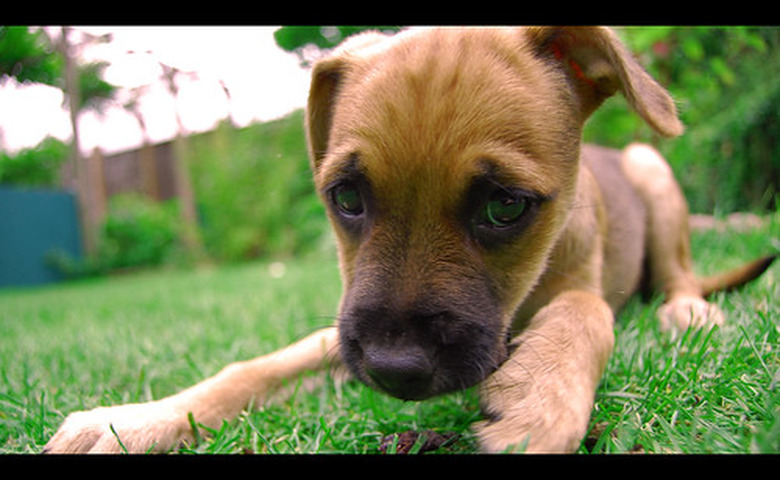Heuchera Villosa Plant & Dogs
One mark of a responsible dog owner is researching the plants in her garden to ensure they are safe for her pooch, should he decide to try them as a snack. Dogs are curious creatures who love to explore, often with their mouths. Gardeners with pooches know to supervise their dogs when they are around potentially hazardous plants and plan accordingly. The Heuchera villosa plant is beautiful to look at, and your dog may feel the same. Finding out whether this plant is harmful can go a long way in keeping Fido safe from harm.
Identification
Heuchera villosa, colloquially known as hairy alumroot or coralbells, is an evergreen perennial that is native to the eastern United States, extending as far north as parts of Canada and south to Mexico. This purple leafed plant prefers rocky outcroppings and is often grown in rock gardens or along gravel pathways. Heuchera villosa prefers well drained soil of a neutral acidity, and grows best in partial shade.
- One mark of a responsible dog owner is researching the plants in her garden to ensure they are safe for her pooch, should he decide to try them as a snack.
- The Heuchera villosa plant is beautiful to look at, and your dog may feel the same.
Considerations
The American Society for the Prevention of Cruelty to Animals (ASPCA) Poison Control Center lists alumroot as non-toxic for cats, horses and dogs. This classification means that the plant will not cause any lasting or serious effects when ingested. This does not mean, however, that the plant is safe for your dog to consume in large quantities. Any plant matter has the potential to cause stomach upset when ingested. Vomiting, diarrhea and mild depression may occur, but this is not cause for concern.
Significance
Because hairy alumroot is listed as non-toxic, it can safely be planted in areas that your dog frequents. If your dog ingests this plant, there is no inherent need to speak to a veterinarian or animal poison control center. Supervision is recommended to keep your dog from eating himself to sickness in your garden.
- The American Society for the Prevention of Cruelty to Animals (ASPCA) Poison Control Center lists alumroot as non-toxic for cats, horses and dogs.
- Because hairy alumroot is listed as non-toxic, it can safely be planted in areas that your dog frequents.
Warning
If your dog exhibits symptoms lasting longer than a few hours or symptoms progressively get worse, you should consult a licensed veterinary care professional. Problems such as lack of appetite, thirst, dizziness, loss of coordination or unconsciousness are symptoms of a serious problem. These problems are not caused by ingestion of the Heuchera villosa plant. If Heuchera villosa was wrongly identified or another, toxic plant was ingested in conjunction with Heuchera villosa, these problems may ensue.
Solution
When planning your garden or buying plants, make sure you know the scientific name of the plant you are buying. There are approximately 50 plants within the genus Heuchera, some of which are known to cause issue when eaten by dogs. In addition to this, there are a number of plants that resemble the purple foliage of hairy alum root. To avoid confusion, cross reference the scientific name of the plant you have with a list of toxic and non-toxic plants, such as the one issued by the ASPCA.
- If your dog exhibits symptoms lasting longer than a few hours or symptoms progressively get worse, you should consult a licensed veterinary care professional.
- There are approximately 50 plants within the genus Heuchera, some of which are known to cause issue when eaten by dogs.
References
- ASPCA: Toxic and Non Toxic Plant List: Dogs
- "Heucheras and Heucherellas: Coral Bells and Foamy Bells;" Dan Heims, Grahame Ware; 2005
- "The American Red Cross and The Humane Society of the United States – Pet First Aid"; Bobbie Mammato, DVM; 1997
